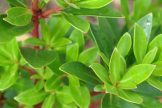
Composting is a natural biological process, which converts wastes to rich organic humus. This process is carried out by organisms, both microscopic and larger, including bacteria, fungi, worms and insects.
Apart from the obvious benefits that compost has in our gardens, we should all remember that the natural biological process of composting converts wastes to rich organic humus… that means it’s extremely environmentally friendly.
Although composting happens naturally, gardeners can make the most of this rich end product by making their own compost. Instead of unthinkingly discarding household waste, which is only lost in our already overburdened landfills, composting can make good use of up to 80% of kitchen scraps and 100% of garden pruning waste.
Compost made from a variety of materials is a useful soil conditioner. Used in the garden, compost will improve soil structure; provide nutrients and humus to the soil, attracting helpful worms; reduce water use by acting as a “sponge” in the soil; and provide the basis for home gardeners to produce their own organic fruit and vegetables.
There seem to be as many ways to compost wastes as there are compost bins in the world. Some methods are more effective than others. Most achieve the same end product; the main difference being the time taken and the nutrient value of the compost.
As most of us are well aware, compost is a fantastic supplement to every garden. As an addition to existing soil, compost will add nutrients, but its main advantage is that of improving soil structure. As a result, compost should be viewed as a soil conditioner, rather than a straight fertiliser. “Healthy soil means healthy plants”, so using compost to improve the soil is better than just adding fertilisers to get plants going. Compost adds body and water holding capacity to sandy soils; and opens up clay soils, especially when added in conjunction with gypsum.
Clay soils benefit from the regular addition of compost to help “fluff up” the soil and make it more friable and easy to dig. (gypsum alone won’t unlock clay soils – compost is needed to keep it open) On the other hand, sandy soils need compost to bulk up the soil and also make it less hydrophobic so water doesn’t run straight through. This means that it can reduce water use by acting as a “sponge” in the soil.
Compost also attracts helpful worms to the garden and will provide the basis for home gardeners to produce their own organic fruit and vegetables.
In the warmer months compost is useful as a garden mulch to conserve soil moisture and keep the soil cool over summer.
Making your own compost
Although composting happens naturally, gardeners can make the most of this rich end product by making their own compost. Instead of unthinkingly discarding household waste, which is only lost in our already overburdened landfills, composting can make good use of up to 80% of kitchen scraps and 100% of garden pruning waste.
Use vegetable scraps, garden clipppings and prunings to make your own compost. One easy way is to layer the fresh clippings to about 10-15cm depth with brown leaves, torn up newspaper or other carbon-based materials, sprinkle with a handful of blood’n’bone or other manure; wet through thoroughly, then repeat the layering. An open heap measuring 1m x 1m x 1m works really well.
All biodegradable material will eventually compost, but meat scraps, dairy products and pet droppings are not recommended for home compost heaps because they don’t reach high enough temperatures to break down the nasty stuff. On the other hand, herbivore animal manure (horses, goats), vegetable kitchen and garden waste are all excellent raw materials for home composting.
Homemade compost actually introduces more helpful micro-organisms to the soil than matured compost, because it hasn’t been broken down as much. As a result it should just be applied to the soil surface in 20mm layers and not dug through, then cover it with mulch. Planting shouldn’t take place in these soils for a few weeks to allow for the compost to be incorporated into the soil layer.
Guidelines for a healthy compost heap
In summer, compost can be produced from raw materials in six weeks to a few months. In winter it may take 4-5 months. All containers are good for composting but ensure that the bottom of the container is the actual soil below, unless you are using a tumbling compost bin.
Open / aerobic composting
A heap with proportions 1 metre x 1 metre x 1 metre allows a good build-up of heat, which accelerates decomposition. Aerobic composting is carried out in an uncovered heap, making use of the maximum amount of air. It produces compost quickly, which is moderately high in nutrients and releases these rapidly when used as a garden fertiliser or mulch.
Closed/ semi-aerobic composting
The closed composting method uses a sealed or covered container, such as a plastic compost bin. It is a slower process, but provides much more concentrated humus. This can be used as a slow-release fertiliser, providing nutrients over a few months. Problems with smells and vermin are also reduced using this method. NB The high temperatures reached during the composting process (up to 70 degrees C) are sufficient to sterilise many disease-causing organisms. Also, fungi present produce antibiotics, which kill many pathogens.
The “rule of thumb and nose” is useful to judge a heap:
- it should feel hot and moist inside
- a slight smell of ammonia indicates nitrogen levels are sufficient for micro organisms to carry out decomposition. A strong ammonia smell signals too much nitrogen is present. Add some carbon-containing material. As a guide, young, green plant matter has a ratio of Carbon to Nitrogen that is balanced for effective composting. Dead material is low in Nitrogen and high in Carbon. Remember, anything that was once part of something living can be added to the heap, but the compost produced will only be as nutrient-rich as the material in it.
Some easy and effective methods are described as follows:
Fast Composting Method
This is effective if you have a lot of material on hand ready to add to your bin all at once. It will produce ready-to use compost in as little as 2 weeks. You will need a combination of any of the materials listed:
1. lots of kitchen scraps, green prunings, grass clippings – with thicker stalks chopped down before adding
2. lots of animal manure, or concentrated organic fertilisers, such as blood & bone, or Dynamic Lifter. Do not put dog or cat droppings in the compost bin, as these may contain diseases, which are harmful to your health.
3. dried leaves, shredded newspaper, straw, fine bark chips, wood shavings (not treated woods),
4. water, preferably with some liquid fish or seaweed emulsion added.
Method
Place the bin directly on the soil. Starting with a layer of items from group 3 above, add all of the materials to the bin to a depth of 5 to 10cm thick. If using the concentrated organic fertilizers, add enough only to cover the previous layer. Alternate the layers, making sure that after each layer, water is added, enough so that the materials are thoroughly moistened. Aim to add enough to fill the bin to 80% capacity.
Leave the contents to settle for about a week. After this time, using a garden fork or other tool, aerate the heap. This involves trying to turn over as much of the materials in the bin as possible. If the heap is heating properly, you may even see steam rising from the centre!
Do this at least every 3 days and very soon all of that waste matter will have turned into rich, sweet smelling humus, ready to use in your garden.
Low Maintenance Method
This method produces compost eventually. It still requires some input; the more you do, the faster the process.
- Place the bin directly on the soil, in a sunny part of the garden.
- Add some twigs or shredded woody material at the base.
- As you collect kitchen scraps or other composting materials, keep adding them to the heap.
- Once a week, shred a few newspaper sheets and put this into your bin. Using a garden fork, turn the contents over to allow the stuff on top to mix through.
- Doing this only will mean your bin will never fill as the material keeps breaking down. You’ll need to decide when you want to stop and allow it to mature. At this point start another bin.
The heap may at times appear to be:
too dry – add some water
or
too wet – add some dry matter, such as torn up newspaper or dried leaves
or
smelly – use a garden fork or other tool to occasionally (at least fortnightly) turn over the contents of the heap. Do not put meat, fish, cheese, pasta or bread in the compost, as these can make the bin smell and attract vermin to the bin. It is possible to compost these materials, but in small suburban gardens where unpleasant odours and vermin are a problem it is best to avoid putting these in your bin. Add a handful of garden lime to neutralize the acidic materials causing the odours. Zeolite may also help to reduce
odour.
When you remember, add some concentrated organic fertiliser, such as blood and bone; or any other manures you can get your hands on. This will help ensure that the final composted product will contain some useful nutrients.
Using finished compost
Your compost is ready to use when none of its original contents are recognizable. Finished compost should look like a potting soil, with uniformly sized pieces and with a faint sweet earthy smell. As an addition to existing soil, compost will add some nutrients, but its main advantage is that of improving soil structure. It adds body and water holding capacity to sandy soils; and opens up clay soils, especially when added in conjunction with gypsum.
Compost is useful as a garden mulch to conserve soil moisture and keep the soil cool over summer. If your garden already has a mulch cover, scrape some aside, add the compost directly over the soil and then re-cover with the existing mulch. Compost can be added to potting soil in a ratio of about 1 part compost to 5 parts potting mix. This is a cost-saving way of filling large containers; and can be used to top up existing containers.
Matured compost, like the Organic Compost we have here at BAAG, is suitable to lightly till through existing soil. However you don’t want to add too much compost to the soil. It should make up no more than 30% of the total mix.
Compost should also be incorporated into planting holes of fruit and other trees and shrubs, by mixing it with some of the soil which has been taken from the hole.
If the garden already has a mulch cover, simply scrape some aside, add the compost directly over the soil and then re-cover with the existing mulch. Compost can also be added to potting soil in a ratio of about 1 part compost to 5 parts potting mix. This is a cost-saving way of filling large containers; and can be used to top up existing containers.
Tips for healthy compost
Getting the Carbon to Nitrogen Ratio correct allows the composting process to work fast and effectively. The ratio should be 30 parts Carbon containing compounds to 1 part Nitrogen. Luckily, this need not be as scientific as it seems. Just make sure you mix materials, which are high in either Carbon or Nitrogen together.
Materials high in Carbon:
- Paper
- Sawdust
Materials containing a suitable C/N ratio which break down readily:
- Kitchen Scraps
- Green Leaves
- Lawn Clippings
- Fruit Wastes (not citrus peels)
Materials high in Nitrogen:
- Livestock Manures
- Urine
Moisture Content
The contents of your bin must be neither too wet nor too dry. Too wet and it becomes a sludgy, sour mess; too dry and the decomposition process will slow down and may stop altogether.
Adequate Aeration
Oxygen is required for aerobic decomposition, which ensures that the compost produced is sweet-smelling. Aerate by using a garden fork or similar tool and turn over the contents at least fortnightly.
Quick composting
You can speed up the rate at which compost is made by shredding or chopping up the materials before adding them to the bin. The smaller the pieces, the more quickly they will break down. Make sure your compost bin is in a sunny spot, as the heat generated will help to speed up the composting process.




